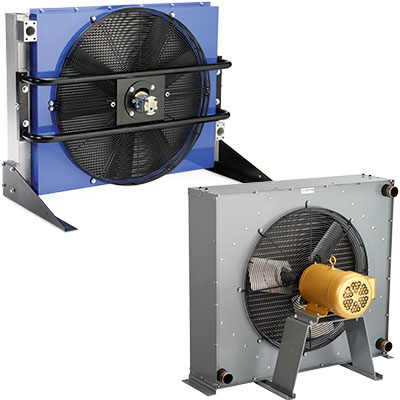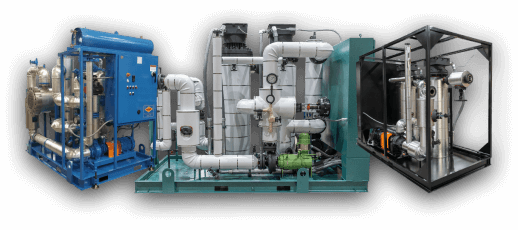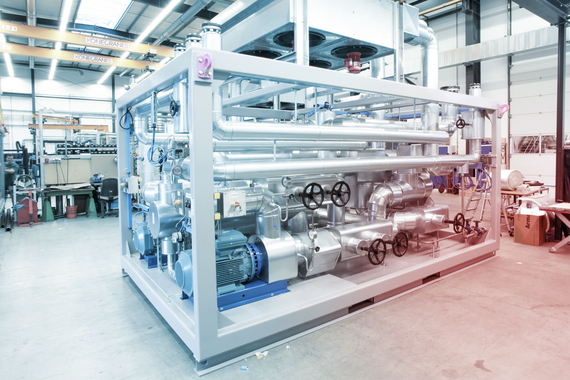Why Choose DVS Heat Transfer Systems for Compact Heat Exchanger Designs
The Role of Heat Transfer Equipments in Sustainable Energy Solutions for the Future
Heat transfer systems are essential in the mission for lasting power options. They enhance thermal power monitoring, boosting the effectiveness of eco-friendly innovations. By using systems like radiation, conduction, and convection, these systems lessen power losses. Their role in solar thermal and geothermal applications is specifically significant. As technologies arise, the capacity for more innovations raises essential inquiries regarding future power methods. What developments will shape the landscape of sustainable power?
Recognizing Heat Transfer Systems

The Importance of Thermal Power Monitoring
Efficient thermal energy management is necessary for making the most of power performance and lessening waste in numerous systems. By controling temperature and enhancing Heat transfer procedures, organizations can markedly decrease energy consumption and operational prices. Reliable administration entails the application of innovative modern technologies and practices that check and regulate thermal conditions within systems, guaranteeing that power sources are used successfully. Additionally, appropriate thermal energy monitoring contributes to reducing greenhouse gas emissions, straightening with international sustainability objectives. It likewise boosts system dependability and performance, causing boosted item quality and longer devices life-span. Ultimately, prioritizing thermal energy administration is a vital action in the direction of producing much more sustainable power options and promoting a liable technique to energy consumption in property and industrial contexts.
Applications of Heat Transfer in Renewable Power
While numerous renewable resource resources promise sustainability, the reliable application of Heat transfer plays an important role in their effectiveness. In wind power systems, Heat transfer is utilized for generator component cooling, improving performance and longevity. Geothermal energy counts on reliable Heat exchange in between the planet's subsurface and the fluid distributing in the system, optimizing power extraction. Biomass energy processes also take advantage of Heat transfer, as it assists in converting organic materials right into useful fuel through pyrolysis and gasification. Furthermore, in hydropower, maintaining suitable temperatures in reservoirs can boost power output. Each of these applications shows the important importance of Heat transfer systems in improving renewable resource technologies, eventually contributing to a more lasting power future.
Enhancing Solar Thermal Power Efficiency
As solar thermal power systems remain to advance, improving their performance has come to be important for making best use of energy outcome. Advancements in Heat transfer innovations, such as enhanced thermal storage space products and innovative Heat exchangers, play a significant duty in enhancing performance. By using sophisticated products that have premium thermal conductivity, systems can transfer and capture Heat better. Additionally, incorporating monitoring systems that comply with the sunlight's path guarantees that enthusiasts receive optimal solar exposure throughout the day. Utilizing nanotechnology in solar absorbers can better enhance energy absorption prices. Moreover, including automatic control systems aids control temperatures and take care of energy circulation efficiently, causing lowered losses and enhanced general system performance. These enhancements lead the means for even more lasting solar thermal energy services in the future.
Geothermal Home Heating: A Sustainable Remedy
Geothermal home heating offers a feasible option for sustainable energy, providing substantial ecological advantages through minimized greenhouse gas discharges. Its effectiveness and cost-effectiveness make it an attractive option to conventional heater. Difficulties related to implementation should be addressed to maximize its prospective impact.
Environmental Advantages of Geothermal
Although traditional heating approaches add considerably to greenhouse gas discharges, geothermal heating provides an engaging option that reduces environmental effect. By utilizing the Earth's inner Heat, geothermal systems utilize a sustainable power source, markedly lowering dependence on fossil gas. This technique generates minimal carbon discharges, making it a cleaner option for industrial and household home heating. Furthermore, geothermal systems promote energy performance, as they call for much less energy compared to standard furnace. DVS Heat Transfer Systems. The utilization of geothermal energy additionally helps in decreasing air contamination, improving regional air quality and public health. As a lasting remedy, geothermal heating sustains climate modification reduction efforts, placing itself as a vital part in the change towards a greener future
Efficiency and Cost-Effectiveness
Exactly how does geothermal heating gauge up in regards to effectiveness and cost-effectiveness contrasted to standard heater? Geothermal home heating demonstrates exceptional efficiency, commonly attaining a coefficient of performance (POLICE OFFICER) of 3 to 5, suggesting it produces 3 to five units of Heat for every single device of electricity consumed. This performance translates right into reduced operating expenses, particularly in regions with stable geothermal sources. First installation costs can be greater than standard systems; nonetheless, lasting savings on energy expenses and reduced maintenance expenses can counter these in advance financial investments. In addition, lots of federal governments incentivize geothermal systems through rebates and tax credit ratings, boosting their cost-effectiveness. Generally, geothermal home heating arises as a financially viable and sustainable alternative to even more conventional home heating services.
Execution Obstacles and Solutions
Various challenges can hinder the extensive application of geothermal furnace, despite their clear advantages as a lasting energy remedy. High first setup costs usually deter investors and homeowners, making financing a substantial barrier. Furthermore, the geographical constraints of appropriate geothermal sites restrict access in certain areas. Regional guidelines and permitting procedures can likewise complicate job advancement, bring about delays. Public recognition and understanding of geothermal systems continue to be reduced, hindering acceptance. To address these challenges, targeted education and learning projects can enhance open secret, while government motivations can alleviate monetary problems. Collaborating with neighborhood authorities to streamline regulations may help with smoother task authorizations, eventually advertising the fostering of geothermal home heating as a sensible, sustainable power alternative.
Advancements in Heat Transfer Technologies
Innovations in Heat transfer modern technologies play an important role in improving energy effectiveness and sustainability. Advanced basics Heat exchangers and stage adjustment products go to the leading edge of these developments, offering significant improvements in thermal administration. These modern technologies not just maximize power use but additionally add to decreasing environmental impact in various applications.
Advanced Heat Exchangers
Advanced Heat exchangers play an essential role in enhancing power effectiveness across different applications in lasting energy solutions. These gadgets help with the transfer of Heat in between two or more fluids, noticeably minimizing energy usage in procedures such as commercial home heating, air conditioning, and power helpful site generation. Technologies in products and style, such as the use of nanofluids and small setups, have actually led to improved thermal performance and decreased dimension needs. In addition, advancements in electronic monitoring and control systems allow for maximized operation, more increasing efficiency. By lessening waste Heat and taking full advantage of energy recuperation, progressed Heat exchangers contribute to reduce carbon footprints and support the change towards environmentally friendly innovations. Their continued growth is crucial for accomplishing worldwide power sustainability goals.
Stage Change Materials
The combination of stage change materials (PCMs) right into Heat transfer modern technologies stands for a considerable development in energy management and efficiency. PCMs take in and launch thermal energy throughout their stage modifications, enabling effective temperature regulation in structure products and power systems. By saving excess Heat during height periods and launching it when demand increases, PCMs add to fill shifting and power conservation - DVS Heat Transfer Systems. This capacity enhances the performance of renewable resource systems, specifically in solar thermal applications. In addition, PCMs can enhance the thermal convenience of indoor atmospheres, reducing dependence on traditional heating and cooling techniques. As innovations in PCM solutions remain to arise, their duty in sustainable energy services is poised to grow, offering promising avenues for future research and application

Future Leads for Heat Transfer in Lasting Power
As the demand for lasting power remedies continues to increase, the function of Heat transfer systems is coming to be increasingly important in forming future innovations. Innovations in materials and layouts are expected to enhance effectiveness in Heat transfer, reducing power losses in different applications. The integration of advanced thermal storage systems, such as stage adjustment materials and thermochemical storage space, will certainly allow far better administration of power sources. Research right into nanofluids and biomimetic Heat exchangers might better enhance thermal efficiency. The adoption of smart innovations will allow for real-time monitoring and flexible control of Heat transfer processes. These improvements are poised to significantly add to the total efficiency and sustainability of energy systems, leading the way for an extra energy-efficient future.
Frequently Asked Questions
How Can People Carry Out Heat Transfer Solution in the house?

People can carry out Heat transfer systems in the house by installing energy-efficient home appliances, using radiant home heating, and enhancing insulation. These measures improve power effectiveness, minimize expenses, and promote lasting techniques in property environments.

What Are the Expenses Linked With Setting Up Heat Transfer Equipments?
The expenses related to setting up Heat transfer systems vary commonly, usually encompassing equipment, setup labor, and maintenance. Aspects such as system kind, home size, and regional policies considerably affect the total expense included.
Are There Federal Government Rewards for Heat Transfer System Installations?
Government incentives for Heat transfer system installations vary by region and can consist of tax obligation grants, rebates, and credit scores. These economic benefits intend to urge adoption, ultimately advertising energy efficiency and decreasing ecological effect within communities.
How Do Heat Transfer Solutions Impact Energy Costs?
Heat transfer systems especially influence power bills by enhancing energy performance. By improving the transfer of Heat, these systems decrease power consumption, causing reduced utility expenses and producing an extra lasting approach to power management.
What Upkeep Is Needed for Heat Transfer Systems?
Upkeep for Heat transfer systems consists of routine inspections, cleansing of components, inspecting liquid degrees, guaranteeing appropriate insulation, and replacing used parts. These tasks help preserve performance, prevent malfunctions, and prolong the system's functional life expectancy.
These systems promote the activity of thermal power from one medium to one more, making it possible for the transfer of Heat for air conditioning, this article heating, or energy generation purposes. Geothermal energy relies on efficient Heat exchange between the earth's subsurface and the liquid flowing in the system, maximizing power removal. Furthermore, geothermal systems advertise energy effectiveness, as they call for less power compared to standard heating systems. Advanced Heat exchangers play a vital role in improving energy efficiency throughout numerous applications in sustainable power options. Heat transfer systems significantly affect power costs by optimizing energy efficiency.